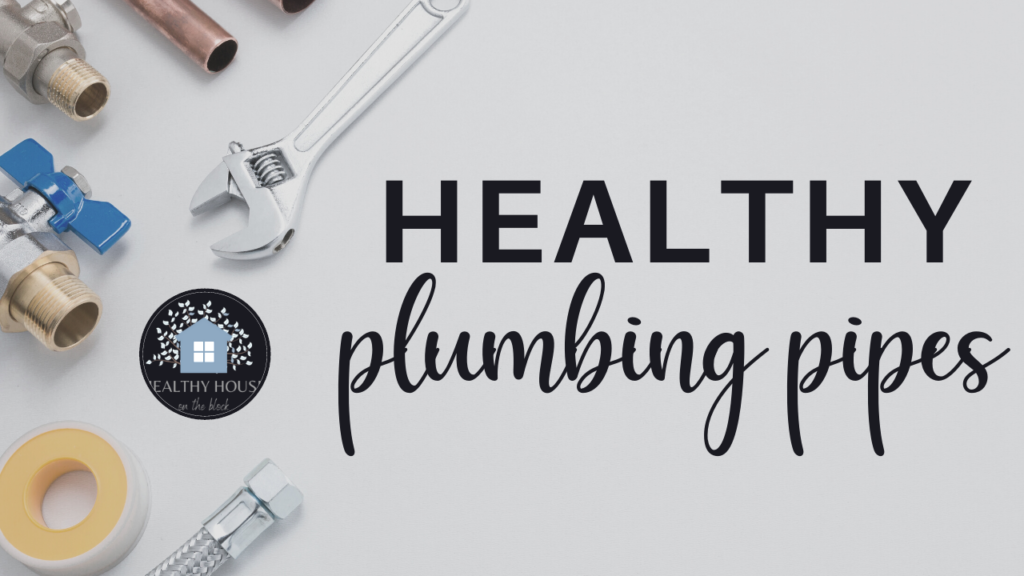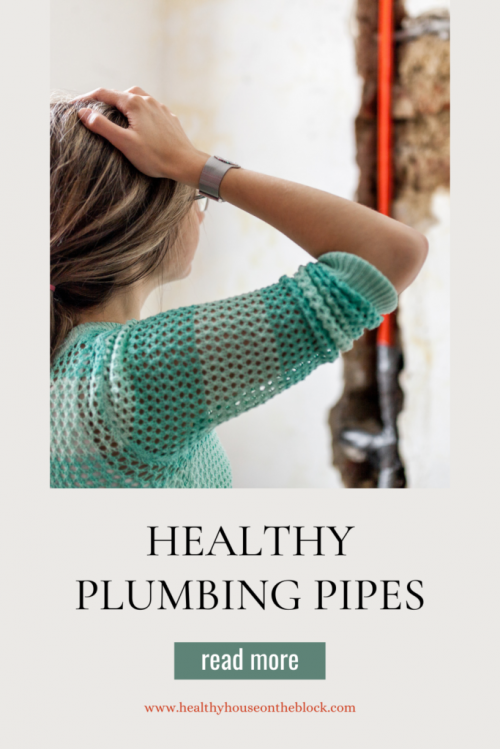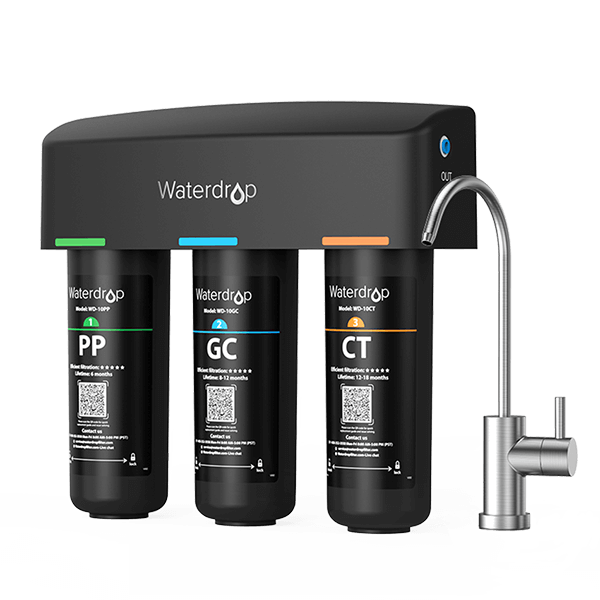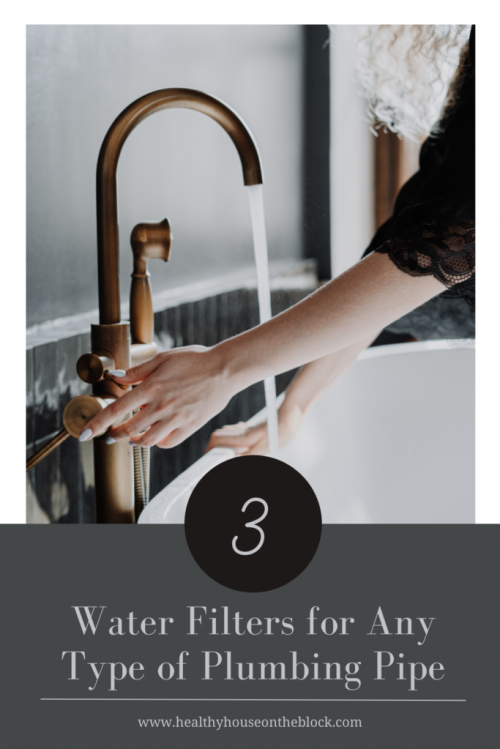
Water is such an important part of a healthy house. If you start to really pay attention to just how much water we use in a day, I guarantee you’ll be so surprised. The biggest concern for most water is the water that we drink because we’re consuming it and allowing it into our bodies. But we’re also bathing in water, where the warmth opens up our pores and allows more toxins to penetrate our skin barrier. And the plumbing pipes that carry our water to our homes can leach toxins into our water.
Plumbing pipes have changed drastically over time, and spoiler alert, there are no 100% toxin free options – still. There are good options and low toxin options. And sometimes as consumers and healthy house owners, that’s the best we can do. I’m really big on the idea that low toxin is still a good option. The best way to go is to choose the lowest option that will work for our family, and then decide not to worry about it.
The silver lining here is that you can get a really high quality water filter system to take your plumbing from low toxin to REALLY low toxin. But even so, if you’re going to do a repipe or you’re building a new home or putting in new plumbing, you might as well start from the least toxic space when it comes to plumbing pipes.
This week’s blog post will share:
- Understanding your home’s plumbing
- Types of materials for plumbing pipes
- Fittings for plumbing pipes
- The lowest toxin material for your plumbing pipes
- Water filters that can take your plumbing to really low toxin
It’s important to understand this area of your healthy home as it plays a huge role in health and wellness.

UNDERSTANDING YOUR HOME’S PLUMBING
The plumbing pipes that we’ll be talking about are JUST for what we call supply piping. Supply piping carries water from your main water supply in your home and branches throughout your home to each plumbing fixture, appliance and faucet. The reason that it’s so important to pay attention to this type of plumbing pipe is because this is where we consume water, which is where we can expose ourselves to a number of toxins.
I don’t necessarily care what the materials for drain, waste or vent piping is simply due to the fact that the material generally doesn’t off-gas, and nothing is being consumed through this piping. These are the pipes that carry water away from your house from your drains and the pipes that connect to plumbing vents to allow air inside your pipes.
Supply piping will be connected together where turns are necessary. These connectors are often in the form of fittings or elbows, and it’s just as important to pay attention to the material of these fittings as it is to look at the piping material itself.

TYPES OF PLUMBING PIPES IN A HOME:
CPVC PIPES: Chlorinated Polyvinyl Chloride is usually a cream colored or off-white plastic tube. It can be used for both hot (up to 180 degrees) or cold water. Most CPVC pipes last for 50 to 80 years. CPVC piping isn’t used as widely as PEX pipes as they are more rigid and it is more work to install. However, it is similar to PEX in the sense that it doesn’t corrode and can withstand higher pressure and temperature.
Studies conducted out of UC Berkeley found that there are more chemicals and toxins being leached out of CPVC pipes (such as chloroform, acetone, and methyl ethyl ketone). If your home has CPVC pipes, make sure you’re using a high quality reverse osmosis water filter system with carbon to reduce the chemicals that would leach into your water.
PEX PIPES: PEX, or polyethylene pipes are becoming the new standard in homes. It’s used for not only supplying water (or your drinking water coming in), but also for hydronic heating systems such as in floor heat. It’s much less expensive than any other plumbing pipe material, and because it is a flexible pipe, it’s often much easier to install. Plumbers need fewer fittings and joints to run piping throughout a space. PEX pipes cannot be used outside, however, as they breakdown under UV rays and reduces it’s ability to withstand chlorine.
While PEX pipes do leach chemicals into the water, it appears that this drops significantly after about 30 days of use. PEX pipes are free from BPA and other bisphenol substitutes such as BPS.

COPPER PIPES: Most homes contain copper pipes run throughout for both hot and cold water. Copper thins out as it ages, and eventually you may see pinhole leaks. There are also various thicknesses of copper, which will be labeled on the pipe as M, L & K (M being the thinnest grade). Copper is considered environmentally friendly as it can be recycled, but it’s generally one of the most expensive plumbing pipe options.
Copper pipes are not 100% toxin free and they do leach heavy metals into water, and they tend to allow more bacteria (with mycotoxins) in your water. Many times the problem with copper is the solder and fittings, which can contain trace amounts of lead.
GALVANIZED STEEL OR IRON: You may see this type of plumbing pipe if you live in an older home (pre 19702). Often the galvanized pipe is treated with a zinc coating that keeps the water from corroding the pipe. Galvanized piping will actually last for 40 – 50 years with no issues, but builders discontinued using it due to the labor and time it took to install.
It would be difficult to find a plumber and materials to install new galvanized steel piping, but you may have older water plumbing pipes made of this material.
Sometimes homeowners have a hard time telling the difference between lead pipes and galvanized steel or iron. In my experience, most lead piping that I have seen in homes is at drains, however, it is possible to have lead pipes in old, old homes for water supply piping. A few tell tale signs to identify lead pipes are:
- Dull, grayish, metal pipes with no sheen
- When scratched with a key or other metal, there is a shiny groove left

FITTINGS ON PLUMBING PIPES:
Fittings for copper pipes are probably the most concerning, as they are made from copper and brass. Even lead free brass fittings can have trace amounts of lead in them, as this was the regulated norm until recently.
Two options for third party certified solders are Canfield Solder and KappZapp Solder.
If you decide to go with Pex pipes, the good thing is there are no exposed fittings or solder necessary. The clamps that hold Pex pipes together are on the outside of the piping as opposed to the inside, like copper.

TOXIN FREE PLUMBING PIPES:
Is PEX toxin free? It’s not, but that doesn’t mean you have to completely avoid it. There are a few things you can do to make PEX piping healthier:
- Look for PEX pipes that meet NSF/ANSI 61 standards. This will ensure that fewer chemicals are leaching into your water.
- Flush your water system after PEX pipes are first installed and if you can help it, avoid drinking water that runs through these pipes for 30 days.
- Filter your drinking water with a high quality reverse osmosis system that has carbon filters
- Avoid drinking warm water from unfiltered tap water.
Is copper the best solution? Probably. Copper, while more expensive, will leach fewer chemicals into your drinking water. That being said, there are precautions I’d recommend you take when installing copper pipes:
- Use a thicker copper pipe like Type L, which is made to withstand abrasion or corrosion
- Use a healthier solder to connect pipes and fittings (Canfield Solder is 100% water safe and free from heavy metals like lead, zinc, arsenic, cadmium and nickel)
- Make sure fittings comply with the NSF/ANSI 372 standard
- Don’t turn your water heater temperature down too low, as this can allow bacteria to grow.
- Filter your drinking water with a high quality reverse osmosis system that has carbon filters
WATER FILTERS FOR DRINKING WATER IF YOU CAN’T CHANGE YOUR PIPES

Ultrafiltration Under Sink Water Filter System Waterdrop TSU-W
This under sink water filter system will decrease chlorine and effectively absorb lead, chloramine, fluoride, heavy metals, VOCs and much more. Because the filter uses KDF media, it is also efficient at removing Mercury.

Waterdrop G2P600 Reverse Osmosis Water Filtration System for Home
This reverse osmosis filter uses a .00001 micron activated carbon block filter that removes atrazine, salt, nitrates, PFAS, fluoride, heavy metals and arsenic as well as more. It improves the taste and smell of your water to be near perfect.

3-stage Under Counter Water Filter System with Dedicated Faucet Waterdrop TSB
This three stage under counter water filter system uses three separate filters to remove chlorine, bad tastes, radon, bacteria, particles and more.

There really is no 100% completely toxin and risk free plumbing pipe option, which means this is an instance where you’ll just choose a low toxin option. If you’re building a new home or you’re repiping a portion of your home, it’s important to not only weigh this information with information from a local plumbing professional. There can be nuances in different regions and areas that may play a big role in the health of your home and plumbing.
Share this:
- Click to share on Facebook (Opens in new window) Facebook
- Click to share on LinkedIn (Opens in new window) LinkedIn
- Click to share on Reddit (Opens in new window) Reddit
- Click to share on Pinterest (Opens in new window) Pinterest
- Click to print (Opens in new window) Print
- Click to share on X (Opens in new window) X



